Class 10 Biology Notes For Components Of Ecosystem Food Chains And Webs
How does the food prepared by green plants or stored in dead matter move in a series of organisms feeding on one another?
Trophic Levels
They are levels in the biotic community at which organisms obtain their food.
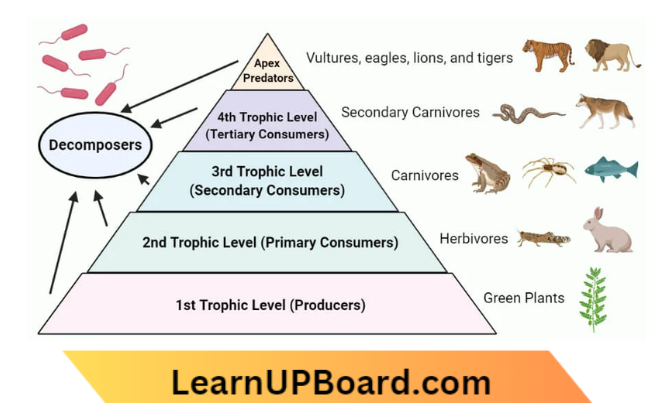
biotic components and abiotic components
- First Trophic Level (T1). It is the level of food manufacturers or producers which prepare food from inorganic raw materials with the help of solar energy.
- Second Trophic Level (T2). It is the level of herbivores or primary consumers which directly feed on plants or plant parts.
- Third Trophic Level (T3). It consists of primary carnivores or secondary consumers which prey upon herbivores.
- Fourth Trophic Level (T4). It is the level of secondary carnivores or tertiary consumers which feed on primary carnivores.
- Fifth Trophic Level (T5). It consists of tertiary carnivores which prey upon secondary carnivores.
Food Chains
A food chain is a sequence of trophic levels through which food passes in a biotic community from producers to ultimate carnivores. Here, members of one trophic level become food for members ofthe next trophic level.
Actually food chain is a summary of who eats whom. A food chain may have 3-5 trophic levels. It is rarely more. The various steps of a food chain are producers and various categories of consumers.
- Producers. They constitute the first trophic level (T1) or base of a food chain. Producers manufacture organic food from inorganic raw materials with the help of solar energy. The major producers are plants in terrestrial ecosystems and phytoplankton in aquatic ecosystems.
- Herbivores. They constitute the second trophic level (T2). Herbivores feed on plants or plant parts, for Example caterpillars, grasshoppers, deer, rabbits, mouse.
- Primary Carnivores. They belong to the third trophic level or T3. Primary carnivores or secondary consumers feed on herbivores, Example Frog, Fox.
- Secondary Carnivores. They are generally large-sized carnivores that belong to the fourth trophic level or T4. They prey upon primary carnivores, Example Hawk. Kingfisher.
Terrestrial Food Chains
- Three Steps Forest Food Chain
Plants →Deer →Lion
(producers) (herbivores) (carnivores) - Four Steps Grassland Food Chain
Grass →Insects →Insectivorous Birds→ Hawk
(producers) (herbivores) (carnivores 1) (carnivores 2) - Five Steps Grassland Food Chain
Grass→Insects → Frog →Snake→ Hawk
(producers) (herbivores) (carnivores 1) (carnivores 2) (carnivores 3)
what are the major components of ecosystem
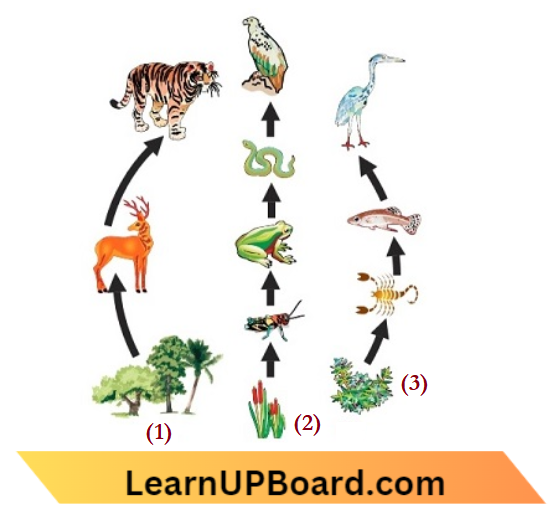
Aquatic Food Chains
1. Four-Step Pond Food Chain
Aquatic →Plants Crustaceans→ Fish →King Fisher
(producers) (herbivores) (carnivores 1) (carnivores 2) (carnivores 3)
2. Five-Step Ocean Food Chain
Phytoplankton →Zooplankton →Small fish →Larger fish →Shark
(producers) (herbivores) (carnivores 1) (carnivores 2) (carnivores 3)
Ecological Pyramids
Ecological pyramids (Elton 1927) arc graphic representations of different ecological parameters like number, biomass, and energy arranged successively with producers at the base, herbivores above them, followed by primary carnivores and top carnivores at the top. The quantity is indicated by the length of the box. It is also written in figures.
Pyramid of Numbers. It is a graphic representation of the number of individuals in a unit area sequence-wise with producer the base, herbivores above them, carnivores L carnivores successfully above them. Only very few top carnivores are supported by a producer population of millions of grassland.
major components of ecosystem
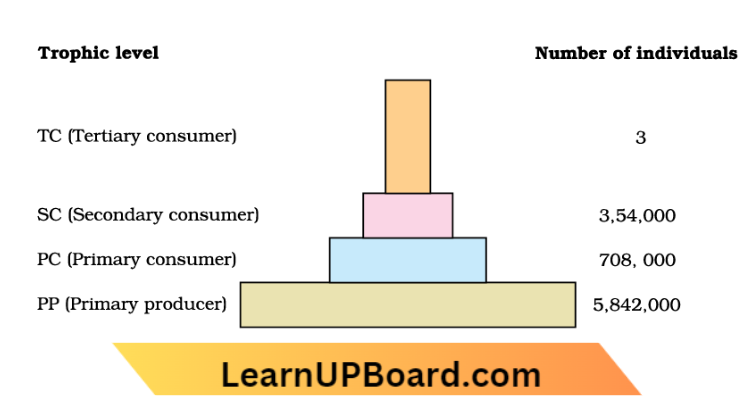
Pyramid of Biomass. It is a graphic representation of biomass or living organic matter present per unit area sequence-wise with producers at the base, herbivores above them followed by carnivores in various categories. Maximum biomass is present in producers. It decreases stepwise with the rise in trophic level.
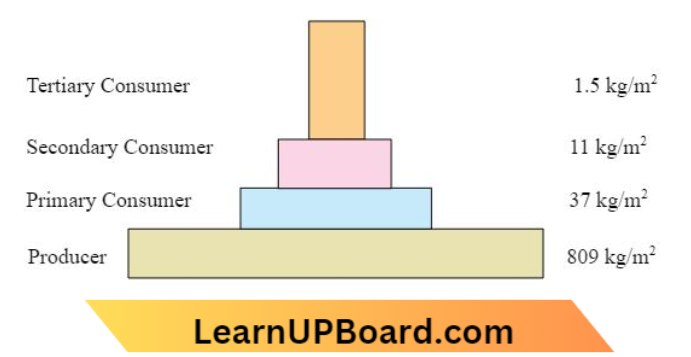
Pyramid of Energy. It is a graphic representation of energy contained per unit area in various trophic levels with producers at the base, herbivores above them followed by carnivores. Maximum energy is contained in producers with a minimum in the top carnivores.
Flow of Energy and Ten Percent Law
In any ecosystem the flow of energy is unidirectional. Producers obtain energy from sunlight. About 1% of solar energy falling on leaves is changed into organic food. From here the food energy’ passes into herbivores. Herbivores cannot pass back the energy’ to producers nor do the producers pass back energy into the environment.
Lindeman (1942) found that during the transfer of energy from one trophic level to the next higher trophic level only 10% of energy is transferred. 90% of energy is lost in transfer, digestion, respiration, and other body activities. It is lost to the environment. The phenomenon is called the 10% law.
Because ofthe large amount of energy lost at every’ transfer, energy reaching higher trophic levels becomes small. Because the number of top carnivores is always small.
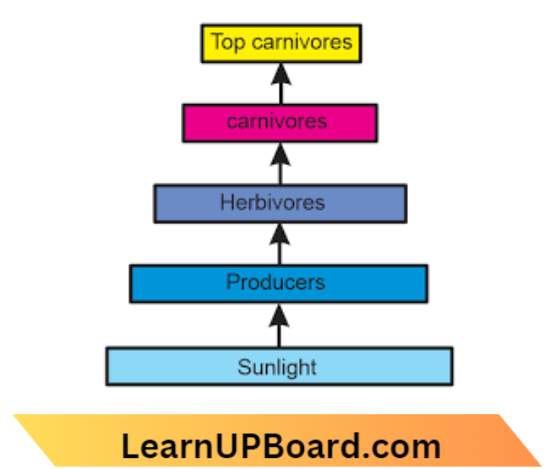
Suppose 1 million Joules of solar energy falls on producers. Producers have 1% efficiency, i.e., they will trap 10,000 Joules of energy in organic food. Herbivores will store 1000 Joules of food energy at 10% efficiency, primary carnivores 100 Joules of food energy while secondary carnivores shall have only 10 Joules of food energy.
Because of the smallness of food energy available at higher trophic levels, both the number of trophic levels as well as members of higher trophic levels will be small.
Biological Magnification (Biomagnification)
What is the phenomenon responsible for the increase in the concentration of persistent chemicals with the rise in trophic levels?
It is an increase in the concentration of persistent soluble chemicals with the rise in trophic levels.
Toxic chemicals are sprayed over crops to protect them from pests and pathogens. They are also sprayed in homes and commercial places to kill insects, mosquitoes, flies, and cockroaches.
Anumberoftoxic chemicals and heavy metals are also released by industries. All these enter waterbodies, soil, groundwater, and then plants. From plants, the persistent chemicals pass into herbivores and from them to carnivores.
Since there is regular entry ofthe chemicals in the food chain, their concentration increases with time in each trophic level. They prove harmful and even fatal to higher trophic-level animals.
Man is also harmed to a great extent as he obtains these chemicals from several sources- water, plant food, milk and meat An example of biomagnification is the study of the concentration of DT in water and the food chain.
Water→Plankton →Small Fish →LargerFish →Fish Eating Birds
0.003pm 0.04 ppm 0.5ppm 2.0ppm 25ppm
The population of fish-eating birds declined in the 1960s due to it. DDT as a pesticide has been banned since then. However, there are several other persistent and toxic chemicals.
Activity 5.5 Pesticide Levels in Food Items and Beverages
Readymade food items and beverages have been found to contain pesticide traces in the past. Many states had to ban the sale of such food items and beverages.
The pesticides are present in the groundwater as well as inside the plant products because they are used to protect the plants from pests.
The sprayed pesticides enter the soil, groundwater as well as water bodies besides the plants and their products. Therefore, beverages and readymade food items prepared from such groundwater as well as plant produce shall contain traces of pesticides.
Farmers must switch over to organic farming where pesticides are not sprayed. Buildings must be provided with double doors. Industries must have safety measures to control pollution.
Food Web
It is a network of several food chains present in an ecosystem where they get interconnected at various trophic levels. It makes each food available to several populations and a population capable of feeding on several foods.
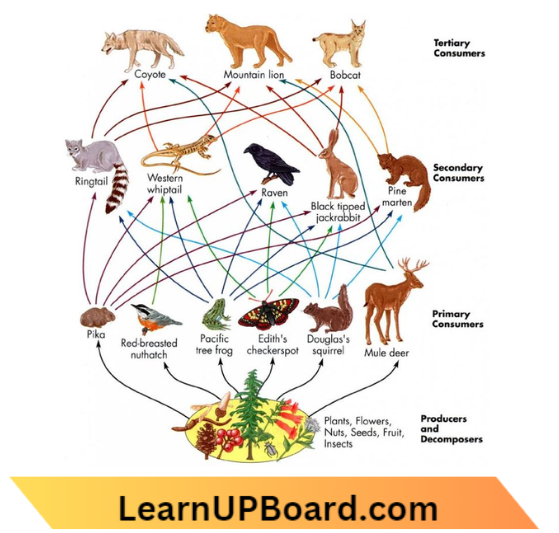
In a food web rabbits can be eaten by foxes, wildcats, wild dogs, jackals, wolves, and hawks. Hawk can feed on snakes, rabbits, and several types of birds. Therefore, in the food web, no consumer is dependent upon a single type of food.
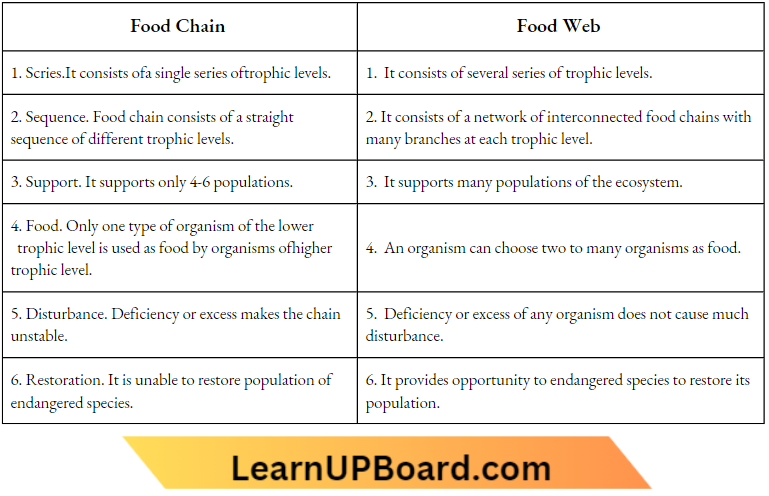
It does not get starved if its favorite food is in short supply. Similarly, if an organism becomes overpopulated, it will be noticed more by predators and therefore, eaten more in number.
On the other hand, an endangered species will not be eaten to a large extent. It will get the opportunity to recover. Thus, the food web is a mechanism for maintaining the stability of an ecosystem.
Question 1. What are trophic levels? Give an example of a food chain and state the different trophic levels init?
Answer: Trophic levels are levels in the biotic community at which organisms obtain their food. The food chain is the sequence of trophic levels through which food passes in a biotic community from producers to ultimate carnivores. A typical grassland food chain consists of the following trophic levels.
Grass →Insects →Insectivorous birds →Hawk
(producers) (herbivores) (carnivores 1) (carnivores 2)
Question 2. What is the role of decomposers in the ecosystem?
Answer: Decomposers are microscopic saprophytes like many bacteria and fungi, which feed on organic remains and organic excretions. They pour digestive enzymes over the organic matter for its simplification and solubilization.
The process releases many inorganic nutrients previously trapped in organic matter. The process is called mineralization. The soluble simple organic substances are picked up by decomposers for their growth. The released minerals become available to plants for their growth and manufacture of food.
Class 10 Biology Notes For Components Of Ecosystem Our Environment Multiple-Choice Questions
Question 1. In an ecosystem, 10% of energy available for transfer from one trophic level to the next is in the form of
- Heat Energy
- Chemical energy
- Mechanical energy
- Light energy
Answer: 2. Chemical energy
Question 2. Soil fertility is determined by its ability to
- Decay organic matter
- Hold organic matter
- Hold water
- Support life
Answer: 4. Support life
Question 3. A food web is constituted by
- Relationship between the organisms and the environment
- Relationship between plants and animals
- Various interlinked food chains in an ecosystem
- Relationship between animals and the environment
Answer: 3. Various interlinked food chains in an ecosystem
Question 4. How much of the net primary productivity of a terrestrial ecosystem is eaten and digested by herbivores?
- 100%
- 10%
- 1%
- 0.1%
Answer: 2. 10%
Class 10 Biology Notes For Components of Ecosystem Our Environment Short Answer Type Questions
Question 1. Construct an aquatic chain showing four trophic levels.
Answer: Algae → Crustaceans → Small Carnivorous Fish → Large Carnivorous Fish.
Question 2. Explain biological magnification with the help of an example.
Answer: Biological magnification or biomagnification is the increase in the concentration of a soluble but persistent chemical per unit weight of an organism with the rise in trophic level. A study on DDT concentration has given the following data.
Water → Plankton → Small Fish → Large Fish → Fish Eating Birds 0.003 ppm 0.04 ppm 0.5 ppm 2.0 ppm 25 ppm
Question 3. Observe the food chain: Plant (1000 J) → Goat → Lion.
- If autotrophs occupy the first trophic level and are called producers what are herbivores called?
- How much energy does the Lion get in the above chain?
Answer:
- Herbivores are primary consumers.
- As per the 10% law, 1000 J of energy in plants is transferred as 100 J of energy in goats and only 10 J in Lions.
Question 4. The maximum concentration of harmful chemicals accumulates in human beings. State the phenomena involved and justify this statement.
Answer: Biological magnification Human beings are omnivorous. They live at the top of every type of food chain. Harmful chemicals enter the human body through groundwater, plant produce, milk, eggs, and meat. They remain in the human body and continue to accumulate. As a result, the maximum concentration of harmful chemicals occurs in human beings.
Question 5. In the food chain, (Grass → Deer→ Lion), operating in a forest what will happen if all the (a)Lions are removed (b) Deer are removed?
Answer:
Removal of lions will result in a rapid increase in the population of deer. The rise in deer population will ultimately result in the eating of the whole grass and desertification of the area. This will cause the death of deer.
The removal of deer will result in excessive growth of grass but no food for lions. As a result, lions will die.
Question 6. List two reasons to show that the existence of decomposers is essential in an ecosystem.
Answer:
- Decomposers feed on organic remains and cleanse the earth of the same.
- They release minerals from organic remains that are utilized by plants for the synthesis of organic matter.
Question 7. A food web is shown as a series of branching lines of food chains. Explain and justify the statement.
Answer: The food web is a network of many food chains that get connected at different trophic levels so that several alternate feeding connections develop amongst the organisms. These alternate feeding connections appear as branching lines of the food chains.
Question 8. Why are bacteria and fungi called decomposers? List any two advantages of decomposers to the environment.
Answer: Bacteria and fungi are called decomposers as they bring about the degradation of organic remains. For this, they secrete digestive enzymes over the organic remains. The enzymes convert complex substances into simple and soluble substances. The latter are used as food by the decomposers. During this decomposition, the inorganic nutrients forming part of organic matter are released.
Advantages: Decomposers cleanse the earth of organic remains. They bring about the release of inorganic nutrients which become available for recycling.
Question 9. What is an ecosystem? List its main components. We do not clean ponds or lakes but an aquarium needs to be cleaned regularly. Explain.
Answer:
Components of Ecosystem, Biotic components are producers, consumers, and decomposers. Abiotic components are climate, soil, topography, inorganic nutrients, and organic remains.
An aquarium is an incomplete and imbalanced artificial ecosystem that lacks producers, food chains, and decomposers. There is no self-cleaning as occurs in ponds or lakes.
Question 10. “Our food grains such as wheat and rice, vegetables, fruits, and even meat are found to contain varying amounts of pesticide residues.” State the reason to explain how and why it happens.
Answer: Cereals, vegetable, and fruit crops are sprayed with pesticides to protect them from pests. These pesticides not only enter the crop plants but also pass into soil, groundwater, and nearby water bodies. Animals drinking the contaminated water and eating pesticide-containing fodder will also come to have the pesticides. Therefore, green vegetables, fruits, and meat will have varying amounts of pesticides.
Question 11. “Energy flow in a food chain is unidirectional.” Justify this statement.
Explain how the pesticides enter the food chain and subsequently get into our bodies.
Answer:
Energy from the sun enters the food chain at the level of producers. The efficiency is 1%. From producers energy (as food energy) passes to herbivores. The efficiency is 10%. The rest of the energy is dissipated in transfer, digestion, and respiration.
Primary carnivores similarly can retain only 10% of the energy obtained from herbivores. Because ofthe regular dissipation of energy at every step and decrease of energy with the rise in trophic level, energy cannot flow back. Thus, its flow is unidirectional from
Sun→producers → herbivores → primary carnivores→ secondary carnivores.
Pesticides are sprayed over crops to protect them from pests. They enter the plants, soil, vegetation, groundwater, and water bodies and hence all types of food chains and from there to humans as man is a consumer of water, crop products, milk, eggs, meat, etc. all of which get contaminated with pesticides.
Question 12. How do pesticides spray over crops and fruit plants enter our bodies and accumulate? Name the phenomenon by which their concentration increases in our body.
Answer: Pesticides sprayed over plants enter their bodies and reach their edible parts. They also seep into the ground and contaminate groundwater. Groundwater also enters plants and further contaminates them.
From vegetables, fruits, other edibles, and groundwater pesticides regularly enter the human body and accumulate. They also enter the food chains which pass the same to human beings. Accumulated pesticides become highly toxic and cause harm to vital organs.
The increase in the concentration of non-biodegradable substances with time and with the rise in trophic levels is called biomagnification.
Question 13. Define an ecosystem. Draw a block diagram to show the flow of energy in an ecosystem.
Answer: Ecosystem. It is a self-sustained segment of nature that has a biotic community and abiotic components of the environment both interacting and exchanging materials between them.
Question 14. Define a food chain. Design a food chain of four trophic levels. If a pollutant enters at the producer level, the organisms of which trophic level will have the maximum concentration of the pollutant in their bodies. What is the phenomenon called?
Answer: Food Chain. It is a sequence of trophic levels through which food passes in the biotic community from producers to ultimate consumers. It is also called the series of eating and being eaten.
Maximum Concentration of Pollutant. Members of the highest trophic level have the maximum concentration of pollutants. The phenomenon of a rise in the concentration of nonbiodegradable pollutants with the rise in trophic levels is called biomagnification.
Question 15.
- Construct a terrestrial food chain comprising four trophic levels.
- What will happen if we kill all the organisms at one trophic level?
- Calculate the amount of energy available to the organisms at the fourth trophic level if the energy available to the organisms at the second trophic level is 2000 J.
Answer:
- Grass → Insects → Frog → Snake.
- If all the organisms of one trophic are killed (/) The animals of higher trophic levels will starve and die Organisms of the lower trophic level will increase.
- 2nd Trophic level → 3rd Trophic level → Fourth Trophic Level
⇒ \(2000 \mathrm{~J}{10 \%} 200 \mathrm{~J} {10 \%} 20 \mathrm{~J} .\)
Question 16. What are decomposers? List two consequences of their absence in the ecosystem.
Answer: Decomposers. They are microscopic organisms like many bacteria and fungi that break down complex components of organic remains and excretions into simpler forms releasing minerals in the process.
Consequences of Their Absence. Organic remains and excretions will pile up (it) There will be no recycling of minerals and other nutrients in nature.
Question 17.
- From the following group of organisms, create a food chain that is the most advantageous for human beings in terms of energy Hawk, Rat, Cereal plant, Goat, Snake, Human beings
- State the possible disadvantage if the cereal plant is growing in soil rich in pesticides.
- Construct a food web using the organisms mentioned above.
Answer:
- Cereal Plants→ Human Beings.
- Pesticides enter the cereal plants and undergo accumulation with the rise of trophic levels as they are non-biodegradable. The phenomenon is called biomagnification.

Question 18.
- Define ecosystem.
- Autotrophs are at the first level of the food chain. Give reason.
- In a food chain of frogs, grass, insects and snakes assign trophic levels to frogs. To which category of consumers do they belong?
Answer:
- Only autotrophs can manufacture food and transfer this food and its energy to the next level of the food chain.
- Grass→Insects→Frogs→Snakes
- Primary consumer Secondary consumer Tertiary consumer
Question 19.
- State the reason for the consequence of the decrease in the number of carnivores in an ecosystem.
- In a food chain, state the trophic level at which the concentration of harmful chemicals is maximum.
- Why is it so?
Answer: (cr) Decrease in carnivores will increase the number of herbivores being their prey.
Top carnivores. The harmful chemicals are non-biodegradable. They accumulate in higher qua rise in trophic level.
Question 20. What is meant by trophic level in a food chain? The energy flow in a food chain is
Answer: Trophic Level. It is the level in the biotic community at which a particular group of organisms obtain Energy flow.
Question 21. Complete the following flow chart based on the ecosystem and its components

Answer:
- Aquatic,
- Abiotic
- Air, water, soil, temperature, light.
- Plants and animals.
Question 22.
- Create a food chain of insects, hawks, Grass, snakes, and frogs.
- Name the organism at the third trophic level.
- Which organism will have the highest concentration of non-biodegradable chemicals?
- Name the phenomenon associated.
- If 10,000 joules of energy are available to frogs, how much energy will be available to snakes
Answer:
- Grass Insect Nake Hawk.
- Frog,
- Hawk
- Biomagnification
- 1000 joules (10,000/10).
Question 23. What is an ecosystem? List any two natural ecosystems.
We do not clean ponds or lakes, but an aquarium needs to be cleaned regularly. Why
Answer: Pond ecosystem, Forest ecosystem.
Question 24. In the following food chain, only 2J of energy was available to peacocks. How energy would have been present in the grass? Justify your answer. Grass→Grasshopper→ Frog → Snake→Peacock
Answer: Transfer of energy from the lower to the next higher trophic level follows the 10% law. 2 J energy in a peacock ha from 20 J energy of a snake. 20 J energy of the snake has been obtained from the 200 J energy of the frog.
Frog gets this much energy from the 2000 J (200 x 10) energy of a grasshopper. 2000 J energy of grasshopper has come from 20,000 J (2000 x 10) energy of grass.
Question 25.
- What is meant by garbage? List two classes into which garbage is classified.
- What do we mean when we say that the “enzymes are specific in their action”?
Answer: Garbage is rubbish formed of mostly household waste and similar waste from vegetable and fruit markets as well as food industries, Example food left-over, spoiled food, vegetable and fruit peels, tea leaves, milk powder, polythene bags, wrappers, broken crockery, paper waste clothes, waste plastic and metallic articles.
Garbage consists of two types of waste, biodegradable and non-biodegradable. Biodegradable Garbage.
It is garbage that gets decomposed naturally by microbes, for Example, vegetable and fruit peels, food leftovers, paper, etc. Nonbiodegradable Garbage. It is garbage that cannot be disposed of by microbes, for example, broken crockery, plastic, and metallic wastes.
Enzymes are specific for various substrates. They require a particular pH temperature for their activity.
Question 26.
- Human beings are most adversely affected by biological magnification. State the reason.
- Why can ordinary washing of edibles (fruits and vegetables) not reduce the effect of biological magnification?
Answer: Biological magnification is the increase in the concentration of non-biodegradable or persistent chemicals with the rise in trophic level.
As human beings occupy the top position in various food chains, they receive the maximum concentration of these chemicals. Being long-lived, the harmful chemicals accumulate in the human body and cause toxic effects.
Washing vegetables and fruits can remove harmful chemicals from their surface. However, it cannot remove nonbiodegradable chemicals as they occur inside the food items.
Question 27.
- What are trophic levels in a food chain?
- Explain the flow of energy through the food chain.
- Write a four-trophic level food chain.
Answer:
- Trophic Levels. They are levels in the biotic community at which organisms obtain their food. Producers constitute the first trophic level (T1), herbivores the second trophic level (T2), primary carnivores the third trophic level (T3), and so on.
- Flow of Energy Through Food Chain.
- Grass →Insect →Insectivorous bird→Hawk.
